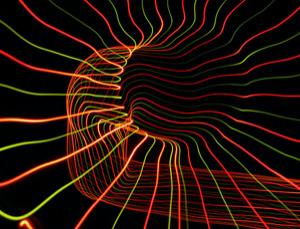WHY can't we be in two places at the same time? The simple answer is that it's because large objects appear not to be subject to the same wacky laws of quantum mechanics that rule subatomic particles. But why not - and how big does something have to be for quantum physics no longer to apply? Ripples in space-time could hold the answer.
The location of the boundary between the classical and quantum worlds is a long-standing mystery.

One idea is that everything starts off as a quantum system, existing in a superposition of states. This would make an object capable of being, for example, in many places at once. But when this system interacts with its environment, it collapses into a single classical state - a phenomenon called quantum decoherence.
Brahim Lamine of Pierre and Marie Curie University in Paris, France, and colleagues say that gravitational waves may be responsible for this. These waves in the very fabric of the universe were generated by its rapid expansion soon after the big bang, as well as by violent astrophysical events such as colliding black holes. As a consequence, a background of ripples at very low amplitudes pervades space-time.
WHY can't we be in two places at the same time? The simple answer is that it's because large objects appear not to be subject to the same wacky laws of quantum mechanics that rule subatomic particles. But why not - and how big does something have to be for quantum physics no longer to apply? Ripples in space-time could hold the answer.
The location of the boundary between the classical and quantum worlds is a long-standing mystery. One idea is that everything starts off as a quantum system, existing in a superposition of states. This would make an object capable of being, for example, in many places at once. But when this system interacts with its environment, it collapses into a single classical state - a phenomenon called quantum decoherence.
Brahim Lamine of Pierre and Marie Curie University in Paris, France, and colleagues say that gravitational waves may be responsible for this. These waves in the very fabric of the universe were generated by its rapid expansion soon after the big bang, as well as by violent astrophysical events such as colliding black holes. As a consequence, a background of ripples at very low amplitudes pervades space-time.